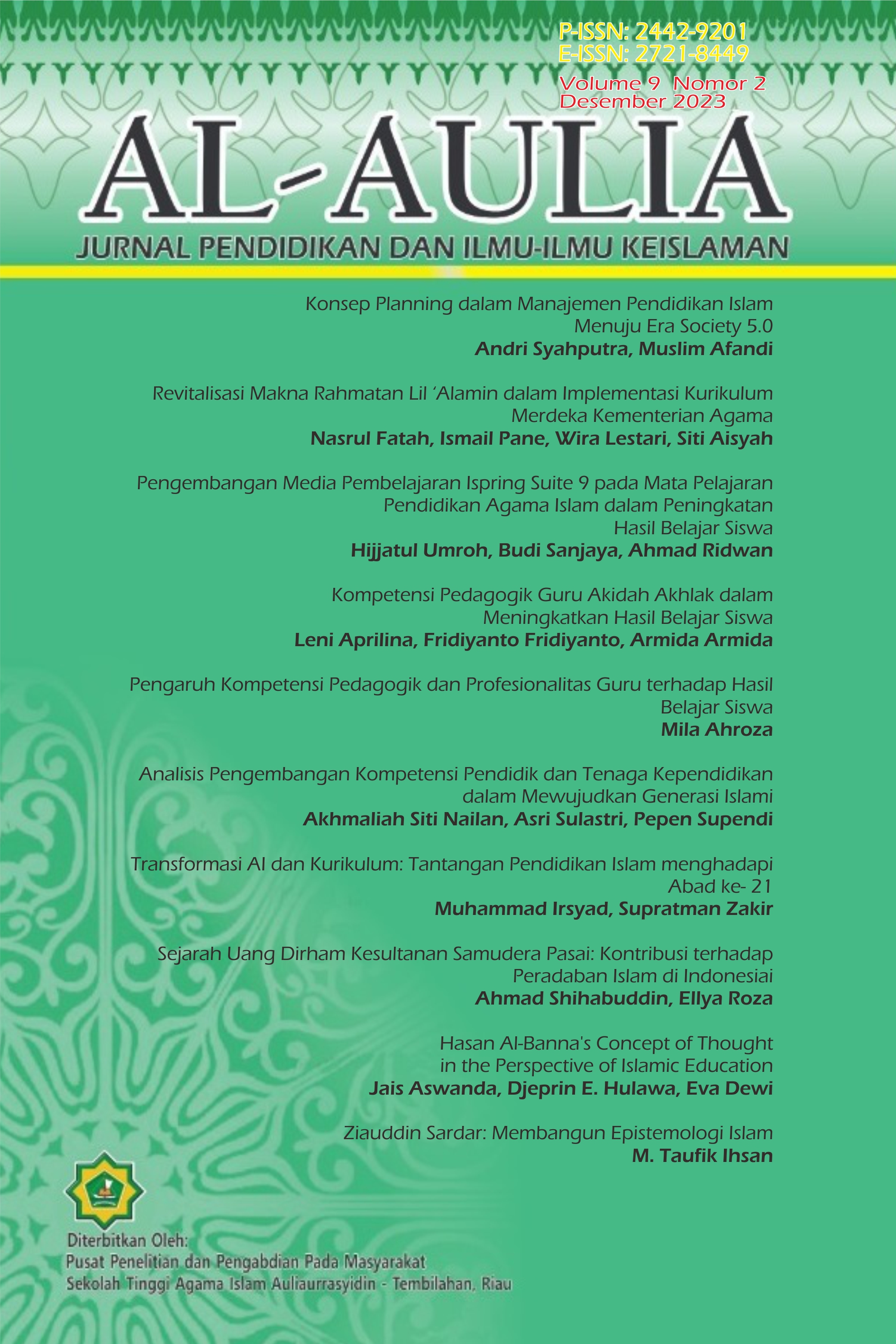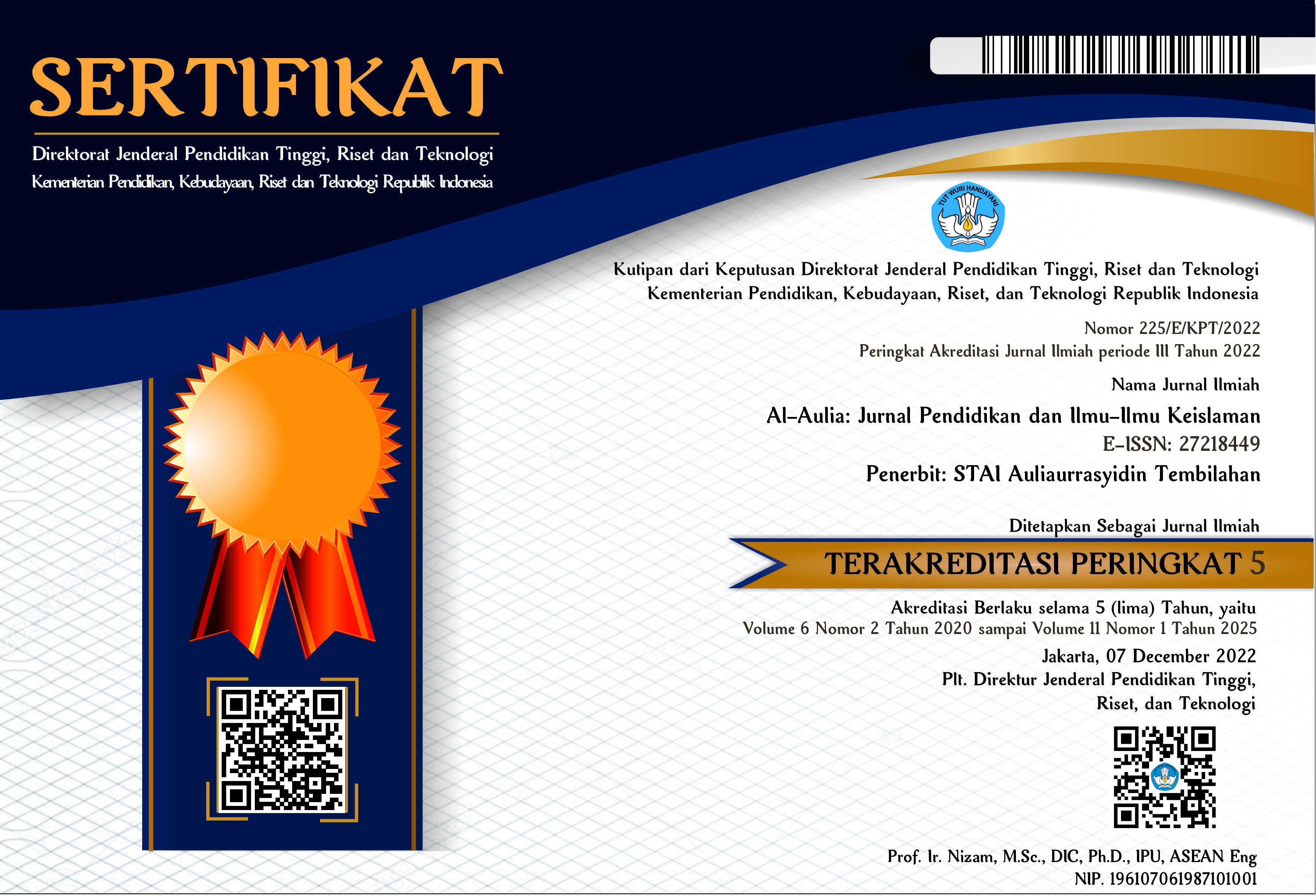Pengembangan Media Pembelajaran Ispring Suite 9 pada Mata Pelajaran Pendidikan Agama Islam dalam Peningkatan Hasil Belajar Siswa
DOI:
https://doi.org/10.46963/aulia.v9i2.1377Keywords:
Learning Media, iSpring Suite 9, Islamic Religious Education, Student learning outcomesAbstract
This research is Research and Development (R&D) research with the ADDIE (Analysis, Design, Development, Implementation, and Evaluation) development model developed by Lee & Owens. With data analysis techniques, namely qualitative and quantitative data obtained from product quality assessment questionnaires and hypothesis testing using one-way ANOVA. This research shows the level of suitability of the iSpring Suite 9 learning media in the subject of Islamic Religious Education, the average assessment by material experts is 4.61 indicating the "Very Appropriate" category, while the average score by media experts is 4.71, which is included in the "Very Appropriate" category. Very Worth It.” As for eligibility, teachers obtained an average of 4.57 in the "Very Appropriate" category, namely in the range 4.2 – 5.0. The results of hypothesis testing show results with a significance level of 0.000 ≤ 0.05. So, Ho is rejected and there is a significant difference between the learning outcomes of students who use the iSpring Suite 9 learning media and those who do not use the iSpring Suite 9 learning media in Islamic Religious Education subjects in improving student learning outcomes.
References
Budiman, Indra Adi, Yuyun dwi Haryanti, and Aida Azzahra. (2021). Pentingnya Media Aplikasi Android Menggunakan Ispring Suite 9 Pada Pembelajaran Daring Terhadap Motivasi Belajar Siswa.” Prosiding Seminar Nasional Pendidikan 3, no. 3 (8): 144-150. https://prosiding.unma.ac.id/index.php/semnasfkip/article/view/575.
Handayani, Denih, and Diar Veni Rahayu. (2020). Pengembangan Media Pembelajaran Interaktif Berbasis Android Menggunakan I-Spring dan Apk Builder. MATHLINE:Jurnal Matematika Dan Pendidikan Matematika 5, no. 1 (11): 12-25. https://doi.org/10.31943/mathline.v5i1.126.
Nuryadi and Nanang Khuzaini. (2016). Evaluasi Hasil dan Proses Pembelajaran Matematika. Yogyakta: Leutikaprio Nouvalitera.
Pribadi, Benny A. Desain dan pengembangan program pelatihan berbasis kompetensi implementasi model ADDIE. Jakarta: Kencana, 2014
Purnamasari, Dwi Ike and Heny Kusdiyanti. (2011). Meningkatkan kemandirian dan hasil belajar peserta didik dengan menggunakan Mobile Learning PERSIKA berbasis ISpring Suit 9. Jurnal Ekonomi, Bisnis dan Pendidikan 1, no. 6 (11): 569-578. https://doi.org/10.17977/um066v1i62021p569-578
Putra, Nusa. (2012). Research and Development: Penelitian dan Pengembangan Suatu Pengantar. Jakarta: Rajawali Press.
Rayanto, Yudi Hari and Sugianti. (2020). Penelitian Pengembangan ADDIE & R2D2. Pasuruan: Lembaga Academic & Research Institute.
Rusdi, M. (2019). Penelitian Desain dan Pengembangan Kependidikan. Depok: Rajawali Press.
Rusmayana, Taufik. (2021). Model penelitian ADDIE Integrasi Padati. Bandung: Widana Bhakti Persada.
Setyosari, Punaji. (2012). Metode Penelitian Pendidikan dan Pengembangan. Jakarta: Kencana.
Sugiyono. (2017) Metode Penelitian Pendidikan Pendekatan Kuantitatif Kualitatif, dan R&D. Bandung: Alfabeta.
Tegeh, I Made, I Nyoman Jampel, and Ketut Pudjawan. (2014). Model Penelitian Pengembangan. Yogyakarta: Graha Ilmu.
Yusuf, Muri. (2017). Metode penelitian Kuantitatif, Kualitatif, dan penelitian gabungan. Jakarta: Kencana.
Downloads
Published
Issue
Section
License
Copyright (c) 2023 Hijjatul Umroh, Budi Sanjaya, Ahmad Ridwan

This work is licensed under a Creative Commons Attribution-ShareAlike 4.0 International License.
Authors who publish with this journal agree to the following terms:
1. Copyright on any article is retained by the author(s).
2. The author grants the journal, right of first publication with the work simultaneously licensed under a Creative Commons Attribution License that allows others to share the work with an acknowledgment of the work’s authorship and initial publication in this journal.
3. Authors are able to enter into separate, additional contractual arrangements for the non-exclusive distribution of the journal’s published version of the work (e.g., post it to an institutional repository or publish it in a book), with an acknowledgment of its initial publication in this journal.
4. Authors are permitted and encouraged to post their work online (e.g., in institutional repositories or on their website) prior to and during the submission process, as it can lead to productive exchanges, as well as earlier and greater citation of published work.
5. The article and any associated published material is distributed under the Creative Commons Attribution-ShareAlike 4.0 International License







